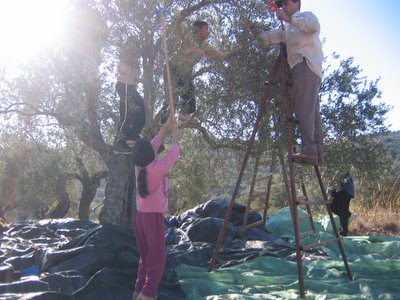Olive harvest

The stone villages of the Palestinian highlands sprawl across hillsides and mountain tops, surrounded by terraced olive groves planted too far ago for anyone to say exactly which came first: the Palestinians or their olives. Some trees are so old – their knobby trunks meters in diameter – that that they are called “Romaneeyeh,” or Roman because the people believe they date to Roman or Byzantine times.
Until a generation ago, the olive harvest was the lifeblood of the rural Palestinian economy. Olives are still harvested by the people who live amongst them, even if they collect them on weekends and days off from their city jobs. Most of the olives are pressed into oil and sold locally. The olive harvest began in many areas after the end of Ramadan, earlier this month, and will continue for another week or so.
A family I have come to know through my research invited me to join them last Friday harvesting olives on their land near the village of Mazara al-Nobani, about an hour’s drive north of Ramallah. I climbed into a pickup truck with three men, three women and six children – all from the same family – and we headed out to the olive trees. On ladders and with small rakes, we picked about 15 trees clean, filling most of three large sacks, each one worth $100 in olive oil.
Mazara al-Nobani is luckier than some. All of its olive trees have been spared Israeli demolition. Since 2000, half a million Palestinian olive trees have been uprooted by Israeli bulldozers, according to the Palestinian Agriculture Ministry. Israel sites security concerns; Palestinians say it’s an effort to drive them from their land.

0 Comments:
Post a Comment
<< Home